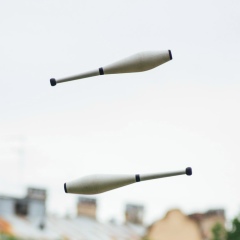Система уровней для проекта Juggling Progress.
Последнее время меня очень увлекает создание разных таблиц. И когда я начал заниматься с Лерой, то решил создать таблицу, с помощью которой можно было бы следить за прогрессом. Такую таблицу, в которой навыки владения мячами, булавами и кольцами соответствовали друг другу и были разделены на несколько этапов.
Всё началось с выбора цели: 7 мячей, 6 колец и 5 булав. Я чувствовал, что эти навыки соответствуют друг другу по сложности, но не знал, чем это можно подтвердить. Ответ нашелся во время подготовки правил к соревнований по спортивному жонглированию. Я зашёл на сайт WJF, и нашёл именно эти цифры в соревнованиях на выносливость.
Правда, если посмотреть мировые рекорды, то выходит, что 5 булав кидать легче (58мин), 7 мячей сложнее(16 мин), а с кольцами вообще творится странное, потому что рекорд с 6 кольцами (6мин) меньше, чем рекорд с 7 кольцами (15 мин). https://juggle.fandom.com/wiki/World_records
Что ж, понятно, что идеального соответствия мы не получим. Булавы сложнее начинать осваивать, чем мячи, и многие, умея кидать 7 мячей, не владеют 5 булавами. Но когда речь идёт о стабильности, то конечно же с 5 объектами легче управляться и рекорд получается больше с булавами.
Тогда я решил подойти с другого конца. Существует сайт jugglingedge.com , о котором я много раз упоминал. Этот сайт имеет огромную базу рекордов от разных людей по всевозможным трюкам. Я решил посмотреть данные пользователей, сравнить их и выявить закономерности. Меня интересовали такие вопросы:
- Сколько бросков 4 мячами сделали те, чей рекорд 5 мячами – около 100 раз?
- Если человек сделал выброс 6 кольцами, сколько бросков он кидает 5 и 4 кольцами?
- Какое соотношение между рекордами с 6 мячами и 3 мячами в одной руке?
Я сравнивал данные множества людей по различным критериям, стараясь объединить всё это в простую и стройную систему. Система получилась и правда довольно красивая. Например, выяснилось, что рекорд по количеству бросков 3 мячей в одной руке обычно соответствует рекорду с 6 мячами. Также в процессе наблюдений я заметил, что умение кидать долго небольшое количество предметов имеет большое значение. Например, те, кто сделал с 4 мячами много бросков, у тех и с 5 мячами результат лучше. Я не знаю, где причина, а где следствие. Но на своём опыте я точно могу сказать, что продолжительное жонглирование помогает лучше прочувствовать эти самые 4 мяча.
Многие считают, что достаточно кидать 100 бросков и трюк освоен. Это красивое число, и 100 бросков вполне достаточно для того, чтобы вставить в номер 10 бросков. Но этого недостаточно, чтобы хорошо чувствовать трюк.
Я сам многие трюки осваивал и пробовал делать их как можно дольше. Так вот, если мой рекорд - 100 бросков, то это означает, что трюк нестабильный и требует много внимания. Если я могу сделать около 500 бросков, то это значит, что он делается точно, но я устаю. А устаю, значит всё-таки много думаю в процессе, а руки не успевают вовремя отдохнуть и накапливают напряжение. И только когда выходит делать более 1500 бросков, я ощущаю что движения лёгкие.
В связи с этим предположением я сделал таблицу, в которой наивысший результат – это 2000 бросков (около 10 минут жонглирования 5 мячами). Я считаю, что до этого количества есть смысл расти. А после 1500-2000 бросков в силу вступают другие физические и психологические составляющие, определяющие получится кидать дольше или нет (такие как выносливость и сила воли)
В процессе создания таблицы я искал другие подобные проекты и нашел три авторитетных источника, использующих на практике свои данные:
1) жонглерский клуб "Jugheads" существует более 25 лет и имеет уровневую систему обучения с экзаменами
https://jugheads.com/school-year-clubs/
2) программа циркового училища, в которой также прописаны нормативы на каждый год обучения.
https://jugglers.ru/forum/zhonglirovanie/olga-0
3) Соревнования WJF, которые подходят только для сравнения трюков 8-10 уровня из моей системы.
http://www.thewjf.com/competition-rules/junio-overall-championship/
Все источники я сравнил со своими данными. Результат можете видеть внизу таблицы. Уровни в разных системах довольно точно совпадают с моими данными, что подтверждает, что система соответствует действительности, а не является лишь голыми цифрами.
Хочу обратить внимание на то, что в таблице некоторые ячейки выделены цветом - это данные, которые отметила Лера с 1 июля по 10 сентября. Как можете заметить, данные по мячам опережают, а по булавам отстают. Скорее всего, причиной такого неравномерного развития является то, что булавы появились у Леры позже, чем мячи и кольца. А кольца немного отстают, так как последний месяц была очень ветреная погода, и жонглировать кольцами было проблематично.
В дальнейшем я буду собирать данные раз в 2 месяца, иначе на установление рекордов уйдет всё свободное время)
Хотите следить за развитием – подписывайтесь в инстаграме на хештег #juggling_progress
Последнее время меня очень увлекает создание разных таблиц. И когда я начал заниматься с Лерой, то решил создать таблицу, с помощью которой можно было бы следить за прогрессом. Такую таблицу, в которой навыки владения мячами, булавами и кольцами соответствовали друг другу и были разделены на несколько этапов.
Всё началось с выбора цели: 7 мячей, 6 колец и 5 булав. Я чувствовал, что эти навыки соответствуют друг другу по сложности, но не знал, чем это можно подтвердить. Ответ нашелся во время подготовки правил к соревнований по спортивному жонглированию. Я зашёл на сайт WJF, и нашёл именно эти цифры в соревнованиях на выносливость.
Правда, если посмотреть мировые рекорды, то выходит, что 5 булав кидать легче (58мин), 7 мячей сложнее(16 мин), а с кольцами вообще творится странное, потому что рекорд с 6 кольцами (6мин) меньше, чем рекорд с 7 кольцами (15 мин). https://juggle.fandom.com/wiki/World_records
Что ж, понятно, что идеального соответствия мы не получим. Булавы сложнее начинать осваивать, чем мячи, и многие, умея кидать 7 мячей, не владеют 5 булавами. Но когда речь идёт о стабильности, то конечно же с 5 объектами легче управляться и рекорд получается больше с булавами.
Тогда я решил подойти с другого конца. Существует сайт jugglingedge.com , о котором я много раз упоминал. Этот сайт имеет огромную базу рекордов от разных людей по всевозможным трюкам. Я решил посмотреть данные пользователей, сравнить их и выявить закономерности. Меня интересовали такие вопросы:
- Сколько бросков 4 мячами сделали те, чей рекорд 5 мячами – около 100 раз?
- Если человек сделал выброс 6 кольцами, сколько бросков он кидает 5 и 4 кольцами?
- Какое соотношение между рекордами с 6 мячами и 3 мячами в одной руке?
Я сравнивал данные множества людей по различным критериям, стараясь объединить всё это в простую и стройную систему. Система получилась и правда довольно красивая. Например, выяснилось, что рекорд по количеству бросков 3 мячей в одной руке обычно соответствует рекорду с 6 мячами. Также в процессе наблюдений я заметил, что умение кидать долго небольшое количество предметов имеет большое значение. Например, те, кто сделал с 4 мячами много бросков, у тех и с 5 мячами результат лучше. Я не знаю, где причина, а где следствие. Но на своём опыте я точно могу сказать, что продолжительное жонглирование помогает лучше прочувствовать эти самые 4 мяча.
Многие считают, что достаточно кидать 100 бросков и трюк освоен. Это красивое число, и 100 бросков вполне достаточно для того, чтобы вставить в номер 10 бросков. Но этого недостаточно, чтобы хорошо чувствовать трюк.
Я сам многие трюки осваивал и пробовал делать их как можно дольше. Так вот, если мой рекорд - 100 бросков, то это означает, что трюк нестабильный и требует много внимания. Если я могу сделать около 500 бросков, то это значит, что он делается точно, но я устаю. А устаю, значит всё-таки много думаю в процессе, а руки не успевают вовремя отдохнуть и накапливают напряжение. И только когда выходит делать более 1500 бросков, я ощущаю что движения лёгкие.
В связи с этим предположением я сделал таблицу, в которой наивысший результат – это 2000 бросков (около 10 минут жонглирования 5 мячами). Я считаю, что до этого количества есть смысл расти. А после 1500-2000 бросков в силу вступают другие физические и психологические составляющие, определяющие получится кидать дольше или нет (такие как выносливость и сила воли)
В процессе создания таблицы я искал другие подобные проекты и нашел три авторитетных источника, использующих на практике свои данные:
1) жонглерский клуб "Jugheads" существует более 25 лет и имеет уровневую систему обучения с экзаменами
https://jugheads.com/school-year-clubs/
2) программа циркового училища, в которой также прописаны нормативы на каждый год обучения.
https://jugglers.ru/forum/zhonglirovanie/olga-0
3) Соревнования WJF, которые подходят только для сравнения трюков 8-10 уровня из моей системы.
http://www.thewjf.com/competition-rules/junio-overall-championship/
Все источники я сравнил со своими данными. Результат можете видеть внизу таблицы. Уровни в разных системах довольно точно совпадают с моими данными, что подтверждает, что система соответствует действительности, а не является лишь голыми цифрами.
Хочу обратить внимание на то, что в таблице некоторые ячейки выделены цветом - это данные, которые отметила Лера с 1 июля по 10 сентября. Как можете заметить, данные по мячам опережают, а по булавам отстают. Скорее всего, причиной такого неравномерного развития является то, что булавы появились у Леры позже, чем мячи и кольца. А кольца немного отстают, так как последний месяц была очень ветреная погода, и жонглировать кольцами было проблематично.
В дальнейшем я буду собирать данные раз в 2 месяца, иначе на установление рекордов уйдет всё свободное время)
Хотите следить за развитием – подписывайтесь в инстаграме на хештег #juggling_progress
Level system for the Juggling Progress project.
Recently, I am very interested in creating different tables. And when I started studying with Leroy, I decided to create a table with which I could monitor the progress. Such a table, in which the skills of possession of balls, clubs and rings corresponded to each other and were divided into several stages.
It all started with choosing a goal: 7 goals, 6 rings and 5 clubs. I felt that these skills corresponded to each other in complexity, but did not know how this could be confirmed. The answer was found while preparing the rules for sports juggling competitions. I went to the WJF website and found exactly these numbers in endurance competitions.
True, if you look at world records, it turns out that 5 clubs are easier to throw (58min), 7 goals are harder (16 minutes), and strange things happen with rings, because a record with 6 rings (6min) is less than a record with 7 rings (15 minutes). https://juggle.fandom.com/wiki/World_records
Well, it’s clear that we won’t get a perfect match. Maces are harder to start mastering than balls, and many, knowing how to throw 7 goals, do not own 5 clubs. But when it comes to stability, then of course with 5 objects it’s easier to manage and the record is more with maces.
Then I decided to approach from the other end. There is jugglingedge.com, which I mentioned many times. This site has a huge base of records from different people on all kinds of tricks. I decided to look at user data, compare them and identify patterns. I was interested in such questions:
- How many 4-goal shots did those whose record with 5 balls - about 100 times?
- If a person made a throw of 6 rings, how many throws does he throw with 5 and 4 rings?
- What is the ratio between records with 6 balls and 3 balls in one hand?
I compared the data of many people according to various criteria, trying to combine all this into a simple and harmonious system. The system turned out and really pretty beautiful. For example, it turned out that the record for the number of shots of 3 goals in one hand usually corresponds to the record with 6 goals. Also in the process of observation, I noticed that the ability to throw a small number of objects for a long time is of great importance. For example, those who made a lot of throws with 4 goals, those with 5 goals have better results. I do not know where the cause is, and where is the effect. But from my own experience I can definitely say that prolonged juggling helps to feel these 4 balls better.
Many believe that throwing 100 throws is enough and the trick is mastered. This is a beautiful number, and 100 shots is enough to insert 10 shots into the number. But this is not enough to feel the trick well.
I myself mastered many tricks and tried to do them as long as possible. So, if my record is 100 throws, then this means that the trick is unstable and requires a lot of attention. If I can make about 500 shots, it means that it is done accurately, but I get tired. But I get tired, it means I still think a lot in the process, but my hands do not have time to relax in time and accumulate tension. And only when it comes out to make more than 1,500 shots, I feel that the movements are easy.
In connection with this assumption, I made a table in which the highest result is 2,000 shots (about 10 minutes of juggling with 5 balls). I believe that up to this amount it makes sense to grow. And after 1500-2000 throws, other physical and psychological components come into effect that determine whether it will be possible to throw longer or not (such as endurance and willpower)
In the process of creating the table, I looked for other similar projects and found three authoritative sources using their data in practice:
1) the juggling club "Jugheads" has existed for more than 25 years and has a level system of training with exams
https://jugheads.com/school-year-clubs/
2) the program of the circus school, which also prescribes the standards for each year of study.
https://jugglers.ru/forum/zhonglirovanie/olga-0
3) WJF competitions that are only suitable for comparing level 8-10 tricks from my system.
http://www.thewjf.com/competition-rules/junio-overall-championship/
I compared all sources with my data. You can see the result at the bottom of the table. The levels in different systems quite accurately coincide with my data, which confirms that the system is true, and not just bare numbers.
I want to draw attention to the fact that in the table some cells are highlighted in color - this is the data that Lera noted from July 1 to September 10. As you can see, the data on the balls are ahead, and the clubs are behind. Most likely, the reason for this uneven development is that the maces appeared at Lera later than balls and rings. And the rings are a little behind, since the last month was very windy weather, and juggling rings was problematic.
In the future, I will collect data every 2 months, otherwise all the free time will be spent on setting records)
If you want to follow the development - subscribe to the hashtag #juggling_progress on Instagram
Recently, I am very interested in creating different tables. And when I started studying with Leroy, I decided to create a table with which I could monitor the progress. Such a table, in which the skills of possession of balls, clubs and rings corresponded to each other and were divided into several stages.
It all started with choosing a goal: 7 goals, 6 rings and 5 clubs. I felt that these skills corresponded to each other in complexity, but did not know how this could be confirmed. The answer was found while preparing the rules for sports juggling competitions. I went to the WJF website and found exactly these numbers in endurance competitions.
True, if you look at world records, it turns out that 5 clubs are easier to throw (58min), 7 goals are harder (16 minutes), and strange things happen with rings, because a record with 6 rings (6min) is less than a record with 7 rings (15 minutes). https://juggle.fandom.com/wiki/World_records
Well, it’s clear that we won’t get a perfect match. Maces are harder to start mastering than balls, and many, knowing how to throw 7 goals, do not own 5 clubs. But when it comes to stability, then of course with 5 objects it’s easier to manage and the record is more with maces.
Then I decided to approach from the other end. There is jugglingedge.com, which I mentioned many times. This site has a huge base of records from different people on all kinds of tricks. I decided to look at user data, compare them and identify patterns. I was interested in such questions:
- How many 4-goal shots did those whose record with 5 balls - about 100 times?
- If a person made a throw of 6 rings, how many throws does he throw with 5 and 4 rings?
- What is the ratio between records with 6 balls and 3 balls in one hand?
I compared the data of many people according to various criteria, trying to combine all this into a simple and harmonious system. The system turned out and really pretty beautiful. For example, it turned out that the record for the number of shots of 3 goals in one hand usually corresponds to the record with 6 goals. Also in the process of observation, I noticed that the ability to throw a small number of objects for a long time is of great importance. For example, those who made a lot of throws with 4 goals, those with 5 goals have better results. I do not know where the cause is, and where is the effect. But from my own experience I can definitely say that prolonged juggling helps to feel these 4 balls better.
Many believe that throwing 100 throws is enough and the trick is mastered. This is a beautiful number, and 100 shots is enough to insert 10 shots into the number. But this is not enough to feel the trick well.
I myself mastered many tricks and tried to do them as long as possible. So, if my record is 100 throws, then this means that the trick is unstable and requires a lot of attention. If I can make about 500 shots, it means that it is done accurately, but I get tired. But I get tired, it means I still think a lot in the process, but my hands do not have time to relax in time and accumulate tension. And only when it comes out to make more than 1,500 shots, I feel that the movements are easy.
In connection with this assumption, I made a table in which the highest result is 2,000 shots (about 10 minutes of juggling with 5 balls). I believe that up to this amount it makes sense to grow. And after 1500-2000 throws, other physical and psychological components come into effect that determine whether it will be possible to throw longer or not (such as endurance and willpower)
In the process of creating the table, I looked for other similar projects and found three authoritative sources using their data in practice:
1) the juggling club "Jugheads" has existed for more than 25 years and has a level system of training with exams
https://jugheads.com/school-year-clubs/
2) the program of the circus school, which also prescribes the standards for each year of study.
https://jugglers.ru/forum/zhonglirovanie/olga-0
3) WJF competitions that are only suitable for comparing level 8-10 tricks from my system.
http://www.thewjf.com/competition-rules/junio-overall-championship/
I compared all sources with my data. You can see the result at the bottom of the table. The levels in different systems quite accurately coincide with my data, which confirms that the system is true, and not just bare numbers.
I want to draw attention to the fact that in the table some cells are highlighted in color - this is the data that Lera noted from July 1 to September 10. As you can see, the data on the balls are ahead, and the clubs are behind. Most likely, the reason for this uneven development is that the maces appeared at Lera later than balls and rings. And the rings are a little behind, since the last month was very windy weather, and juggling rings was problematic.
In the future, I will collect data every 2 months, otherwise all the free time will be spent on setting records)
If you want to follow the development - subscribe to the hashtag #juggling_progress on Instagram

У записи 29 лайков,
1 репостов,
1021 просмотров.
1 репостов,
1021 просмотров.
Эту запись оставил(а) на своей стене Илья Поляков





![Владислав Дорогин [ ВИДЕОГРАФ ] Владислав Дорогин [ ВИДЕОГРАФ ]](https://sun9-27.vkuserphoto.ru/s/v1/ig2/15RRpElfcYVaJGAoRBsxbcLkzWK04mZzpvzsbDm2uVuM-9tLP8yyJLKwuLmviW0Yfwuzc6eJqhVKe2_lYCDOWzA8.jpg?quality=95&crop=204,0,1568,1568&as=32x32,48x48,72x72,108x108,160x160,240x240,360x360,480x480,540x540,640x640,720x720,1080x1080,1280x1280,1440x1440&ava=1&cs=200x200)











































